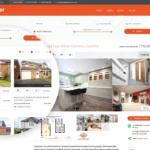We started working with property managers, letting agents and estate agents over 20 years ago, and every single one of them has wanted more traffic coming to their website. The overwhelming thing from their perspective is that there are so many property marketing techniques, where should they start?
Pay-per-clicks or Google AdWords, Facebook advertising, WE Marketing, search engine optimisation, social media, email campaigns, blogging. We’ve all set up, or tried to set up, landing pages, lead magnets, and so on. All, really, to try and get more traffic to our website, get more eyes on the services that we offer, the properties that we have on offer, trying to drive valuations, trying to basically get people to contact you.
We’re getting contacted every week with new things, “If you add this to your website, you’re going to start driving more traffic, or closing more deals, or the return on investments going to be X, Y, Z.”
It can get a little bit over the top. I know everyone’s desperate to try and improve their traffic, get better leads and so on. That’s just obvious, that people want to do that.
The big issue that I see out there at the moment is in the tracking of data and working out exactly what is working and what is not working for your property marketing campaigns.
For example, you might put a landing page on your website, you might go and pay £500 or £1,000 to run some Google AdWords to it, you might put some Facebook adverts out there, you might add a chatbot to the bottom of the landing page. All these things are running at once and you’re going to get a few leads coming through to your inbox on your email, and you’re going to follow it up and get some work out of it, and that’s great. What you don’t know is really where did all those leads come from, specifically.
It’s difficult to track how they got there. Someone may have found you on their mobile, they might have gone home, got onto a laptop or an iPad or something like that, so there’s no attribution of where they initially found you. There are lots of different bits of data out there that aren’t really been analysed, or tracked, or put in an easy way to view some kind of dashboard, to give you a quick overview of what’s working, what’s not working. I think that’s the biggest downfall, a lot of the time and money spent, or 90-95% of the money spent, spent all on the front end, the advertising and the setting up of the pages, the SEO and so on, and it’s a bit of an afterthought of how you actually track that data.
Set your campaign up properly
With all of that in mind, I think it’s important to certainly put a bigger percentage of your time into getting data collection set up. Making sure you’ve got tracking in place before you run any campaigns, is a really important thing. Test if that tracking is working properly, check that you know exactly where that lead has come from, you know what keywords that they’ve searched, how they got to your website, how many times they’ve been on your website and so on. Because quite often, it can take a number of visits over a period of time to actually make the commitment to fill out a campaign form, or pick the phone up and ring you.
Give campaigns time and use AB splits
The other thing I would say is to make sure you give any campaigns that you run enough time to collect reasonable data that you can actually analyse before making any changes.
You need to start thinking about, maybe do some AB split. “What if my headline was this, or my headline was this? How does that affect the number of leads?”
Probably the most important thing is what the cost per lead is. If you’re running multiple campaigns from different platforms, with different tactics, you’re going to get different cost per lead. At the end of a campaign, what you need to be able to do is find out, “Well, which was most successful? Which brought us the most leads for the costs?” Then you can start refining what you’re doing, and maybe going in and changing some of the ways, visually, that you’ve done the campaign. Actually use the data that you get in to help you refine your campaign.
Make sure your campaign targets ONLY the intended audience
There isn’t one campaign out there, unless you’re lucky, that is a hit straight away.
Generally, most of them do need a little bit of tweaking. Learn from mistakes, and from the way customers interact with you. Make sure that the leads you do get are the ones that you want. You don’t want all the leads, because some of them are going to be time-wasters, some are just not the type of people who can afford the property that you’ve got to rent or sell. Try to narrow down your campaigns to be specific to the people that you want.
For example, if you’re renting out a property for £3,000 a month, you can probably work out who you need to try and attract to go and rent that property. If you do it right, you’re may not get as many leads, but then you don’t need as many if they’re all the right ones.
BONUS tip: Avoid vanity metrics
Stay clear off vanity metrics. Quite often you’ll get a report from a pay-per-click company saying, “We got 1000 clicks to your website. We did this and we did that. We got so many views and so on.” They’re vanity metrics, they don’t really matter. We can all get a thousand clicks on a website, but if none of them were any good, then it’s a complete waste of time.
Data, data, data. Making sure you test everything is really, really important in this day and age. In the long run, it will save you time, it will save you money and it will give you a really clear understanding of what it is you need to do. Get in touch to discuss how we can help you utilise data collection for your campaigns.
Book a No-Obligation 30 minutes call with our web design experts
Our 30 minute “getting-to-know-you” phone call is designed to see if your project is something we are able to help with. Be prepared to discuss your business fundamentals, your hopes & expectations of your project and your current business challenges. Schedule a call now.




